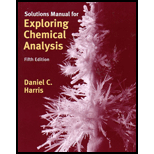
(a)
Interpretation:
Concept Introduction:
(a)
Explanation of Solution
Equilibrium for dissociation of is given as follows:
Value of
Substitute 1.857 for
Equation (2) indicates there is large
Value of
Substitute 7.172 for
Equation (4) indicates there is large
(b)
Interpretation:
Balanced cathodic and anodic half-reactions have to be found.
Concept Introduction:
Cell that is more negatively charge has better oxidation tendency and thus will readily lose electron. Electrons released from this electrode will reach the positive reduction potential electrode.
(b)
Explanation of Solution
Half cell reaction for reduction of water that occurs at cathode is written as follows:
Half cell reaction for anodic compartment when iodide gets oxidized to triodide ion is written as follows:
(c)
Interpretation:
Balanced reactions amongst
Concept Introduction:
Refer to part (a).
(c)
Explanation of Solution
Unbalanced reaction is formulated as follows:
Add 3 as coefficient of
Since there are 4
Since there are 3
Finally, verify each side has equal charge. Thus balanced reaction amongst
Unbalanced reaction between
Add 3 as coefficient of
(d)
Interpretation:
Concentration of total sulfite in undiluted wine has to be calculated.
Concept Introduction:
Refer to part (a).
(d)
Explanation of Solution
Balanced reactions amongst
Balanced reactions amongst
Since
Excess moles of thiosulfate are calculated as follows:
Amount of
Therefore amount of
Number of moles of
Hence, in terms of molar concentration is calculated as follows:
Thus, concentration of total sulfite in undiluted wine is
Want to see more full solutions like this?
Chapter 17 Solutions
Solutions Manual for Exploring Chemical Analysis
 ChemistryChemistryISBN:9781305957404Author:Steven S. Zumdahl, Susan A. Zumdahl, Donald J. DeCostePublisher:Cengage Learning
ChemistryChemistryISBN:9781305957404Author:Steven S. Zumdahl, Susan A. Zumdahl, Donald J. DeCostePublisher:Cengage Learning ChemistryChemistryISBN:9781259911156Author:Raymond Chang Dr., Jason Overby ProfessorPublisher:McGraw-Hill Education
ChemistryChemistryISBN:9781259911156Author:Raymond Chang Dr., Jason Overby ProfessorPublisher:McGraw-Hill Education Principles of Instrumental AnalysisChemistryISBN:9781305577213Author:Douglas A. Skoog, F. James Holler, Stanley R. CrouchPublisher:Cengage Learning
Principles of Instrumental AnalysisChemistryISBN:9781305577213Author:Douglas A. Skoog, F. James Holler, Stanley R. CrouchPublisher:Cengage Learning Organic ChemistryChemistryISBN:9780078021558Author:Janice Gorzynski Smith Dr.Publisher:McGraw-Hill Education
Organic ChemistryChemistryISBN:9780078021558Author:Janice Gorzynski Smith Dr.Publisher:McGraw-Hill Education Chemistry: Principles and ReactionsChemistryISBN:9781305079373Author:William L. Masterton, Cecile N. HurleyPublisher:Cengage Learning
Chemistry: Principles and ReactionsChemistryISBN:9781305079373Author:William L. Masterton, Cecile N. HurleyPublisher:Cengage Learning Elementary Principles of Chemical Processes, Bind...ChemistryISBN:9781118431221Author:Richard M. Felder, Ronald W. Rousseau, Lisa G. BullardPublisher:WILEY
Elementary Principles of Chemical Processes, Bind...ChemistryISBN:9781118431221Author:Richard M. Felder, Ronald W. Rousseau, Lisa G. BullardPublisher:WILEY





